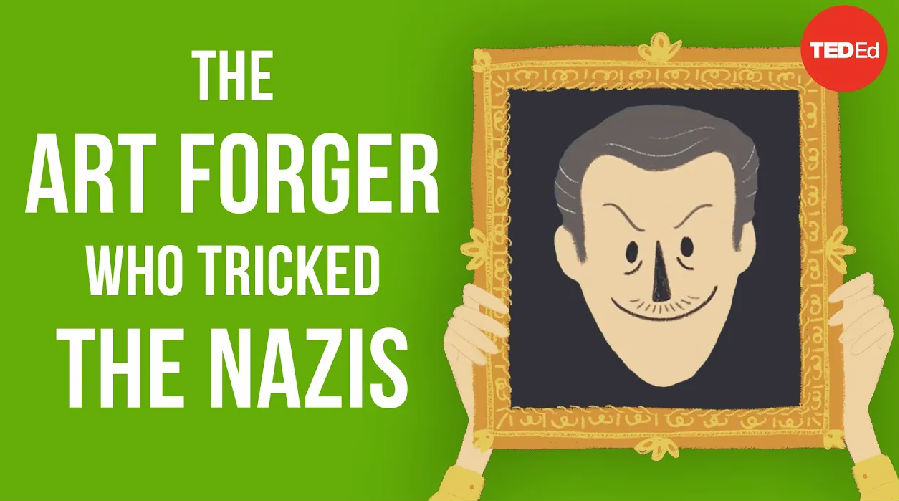It was one of the strangest trials in Dutch history.
这是荷兰历史上最离奇的审讯之一。
The defendant in this 1947 case was an art forger who had counterfeited millions of dollars worth of paintings.
在这宗1947年的案件中,被告是一名艺术伪造者,他伪造过价值数百万美元的赝品。
But he wasn't arguing his innocence -- in fact, his life depended on proving that he had committed the fraud.
但他在案件中却没有在为自己的清白辩护--事实上,他必须证明自己犯了伪造罪,才能保住性命。
Like many art forgers, Han van Meegeren was an artist whose original works had failed to bring him renown.
与其他许多同行一样,汉·范米格伦是一位艺术家,可是他的原创作品并未能让他名声大振。
Embittered towards the art world, van Meegeren set out to make fools of his detractors.
怀着对艺术界的愤懑不平,范米格伦打算给这些有眼无珠的人点颜色瞧瞧。
He learned all he could about the Old Masters -- their biographies, their techniques, and their materials.
他深度剖析那些早期大师们的作品--他研习了他们的传记、技巧和画作材料。
The artist he chose for his deception was 17th century Baroque painter Johannes Vermeer
他的骗局从选择伪造一位17世纪的巴洛克画家开始,约翰内斯·维米尔,
an ambitious decision given Vermeer was famed for his carefully executed and technically brilliant domestic scenes.
这是一个野心勃勃的决定,因为维米尔以技艺精湛的室内画像而闻名。
Working in secret for six years, the forger perfected his art, copying numerous works as practice.
在秘密工作六年后,这位赝造者将自己的画作发挥到了极致,作为练习,他还临摹了很多作品。
He mixed his own paints after researching the raw materials and pigments available in Vermeer's time.
在研究了维米尔时代的画作原材料和染料之后,他用自己的材料混合制成了维米尔使用的颜料。
He bought 17th century canvases, created his own brushes, and aged the works by applying synthetic resin and baking them to dry and crack the paint.
他购买了17世纪的画布,制作了自己的画笔,添加合成树脂,并烘烤让颜料干燥开裂,以制造出年代久远的效果。
A forensic test could have detected the synthetic resin.
鉴定测试本能够检测出合成树脂。
But at the time, such tests were neither advanced nor widespread, and even today verification of a painting's authenticity relies on the assessment of art specialists.
但当时这种测试不够先进和普及,甚至时至今日,画作真伪的鉴定也大都依赖艺术专家的评估。
So it's a matter of their subjective judgment -- as well as their reputation.
所以这关乎到专家的主观判断以及他们的声誉。
And this is where van Meegeren truly outwitted the art world.
这就是范米格伦真正骗过艺术界的地方。
From his research, he knew historians believed Vermeer had an early period of religious painting influenced by the Italian painter Caravaggio.
他通过研究了解到,历史学家相信维米尔早期创作过宗教画,并受到意大利画家卡拉瓦乔的影响。

The leading authority on Vermeer, Abraham Bredius, was a huge proponent of this theory, though none of these works had surfaced.
尽管未曾有人发现过这些作品,研究维米尔的权威人士亚伯拉罕·布雷迪乌斯是这个理论的绝对支持者。
So van Meegeren decided to make one. He called it "The Supper at Emmaus."
于是范米格伦决定自己创作一幅这样的画,并将其命名为《埃马斯的晚餐》。
Bredius declared van Meegeren's fake the masterpiece of Vermeer's oeuvre.
布雷迪乌斯宣称范米格伦的赝品是维米尔作品中的珠玉之作。
Van Meegeren's forgery was not totally up to Vermeer's technical standards,
范米格伦的赝品技术没能完全达到维米尔的水准,
but these inconsistencies could be made to fit the narrative: this was an early work, produced before the artist had come into his own.
但这些违和之处恰好能和维米尔的生平匹配:这是一件早期作品,那时的维米尔还没有成名。
With the stamp of approval from the art world, the fake was sold in 1937 for the equivalent of over $4 million in today's money.
由于得到了艺术界的认可,这件赝品在1937年以相当于现在400万美元的价格卖出。
The success prompted van Meegeren to forge and sell more works through various art dealers.
大获成功的范米格伦继续进行伪造,并通过多个艺术商卖出了更多赝品。
As unbelievable as it may sound, the art world continued to believe in their authenticity.
尽管听上去难以置信,但艺术界一直都相信这些艺术品的真实性。
When the Nazis occupied Holland during the Second World War, Hermann Goring, one of Hitler's top generals,
当纳粹在二战占领荷兰时,希特勒的高级将领之一,赫尔曼·戈林,
sought to add a Vermeer to his collection of artwork looted from all over Europe.
想在他从欧洲各地搜刮的艺术品中加入一幅维米尔的作品。
Van Meegeren obliged, selling him an alleged early Vermeer painting titled "Christ with the Adulteress."
范米格伦答应了,并卖给他一幅据称是维米尔早期的画作,名为《耶稣和淫妇》。
As the tide of the war turned, so did van Meegeren's luck.
随着战情的扭转,范米格伦的运气也即将消失。
Following the Allied victory, he was arrested for delivering a priceless piece of Dutch heritage to the Nazis -- an act of treasonous collaboration punishable by death.
在盟军胜利之后,他因向纳粹交付一幅极其宝贵的被视为荷兰文化遗产的画作而被捕,这种通敌叛国的行为可判死刑。
To prove the painting wasn't a national treasure, he explained step-by-step how he had forged it.
为了证明这幅画作不是国宝,他一步步地解释了自己是如何伪造这幅画的。
But he faced an unexpected obstacle -- the very expert who had enabled his scam.
但他却遇到了一个意想不到的困难--那位使他骗局成功的专家布雷迪乌斯。
Moved to protect his reputation, Bredius defended the painting's authenticity.
为了捍卫自己名誉,布雷迪乌斯坚称这幅画是真品。
With few options left, van Meegeren set to work on a "new" Vermeer.
范米格伦几乎别无选择,只能再次亲手创作一件“新”的维米尔作品。
When he presented the fake to the court, they finally believed him.
当他把赝品呈交给法庭之后,人们终于相信了他。
He was acquitted for collaborating with the Nazis -- and sentenced to a year imprisonment for fraud.
他被免除了与纳粹勾结的叛国罪--却因诈骗罪被判处一年有期徒刑。
Though there's evidence that van Meegeren did, in fact, collaborate with the Nazis,
尽管有证据表明,范米格伦确实与纳粹勾结,
he managed to convince the public that he had tricked Goring on purpose, transforming his image into that of a folk hero who had swindled the Nazis.
他还是设法让公众相信他故意欺骗了戈林,把自己的形象转变为一名敲诈了纳粹的民间英雄。
Thanks to this newfound notoriety, his works became valuable in their own right -- so much so that they were later forged in turn by his own son.
多亏了这次“恶名”的远扬,他本人的作品成了货真价实的名作--以至于他的儿子后来又伪造了他的作品。
The same canvases went from revered classics to despised forgeries to works of art respected for the skill and notoriety of the forger.
同样的画,从备受推崇的经典沦落到受人唾弃的赝品,又因为赝造者的技艺和名声,成为了备受尊敬的艺术作品。


